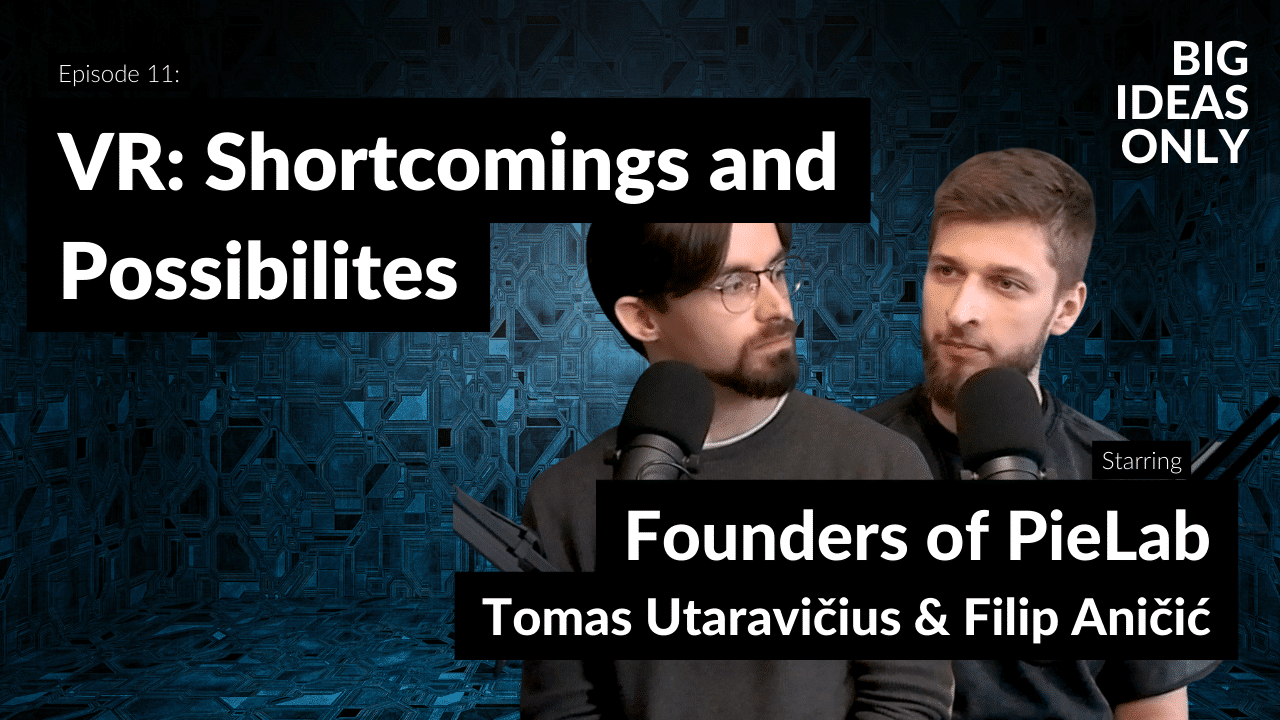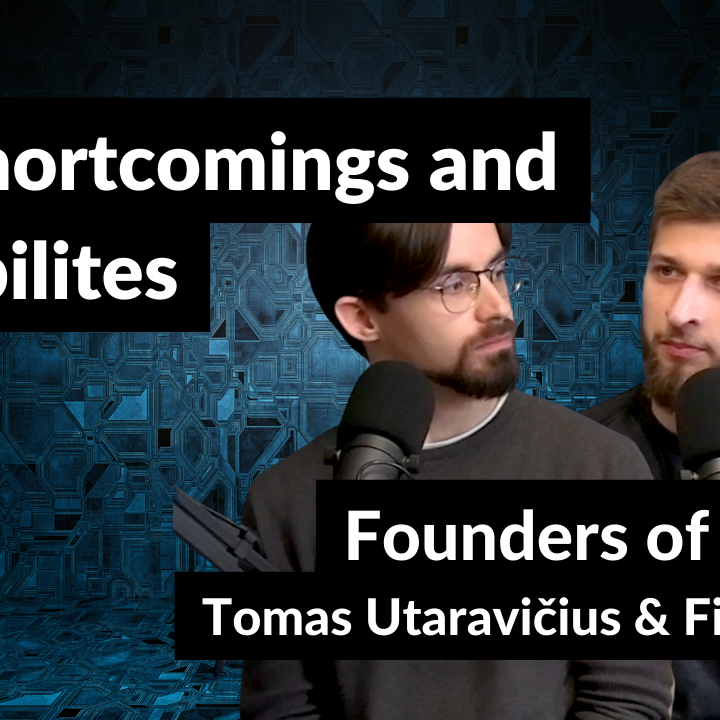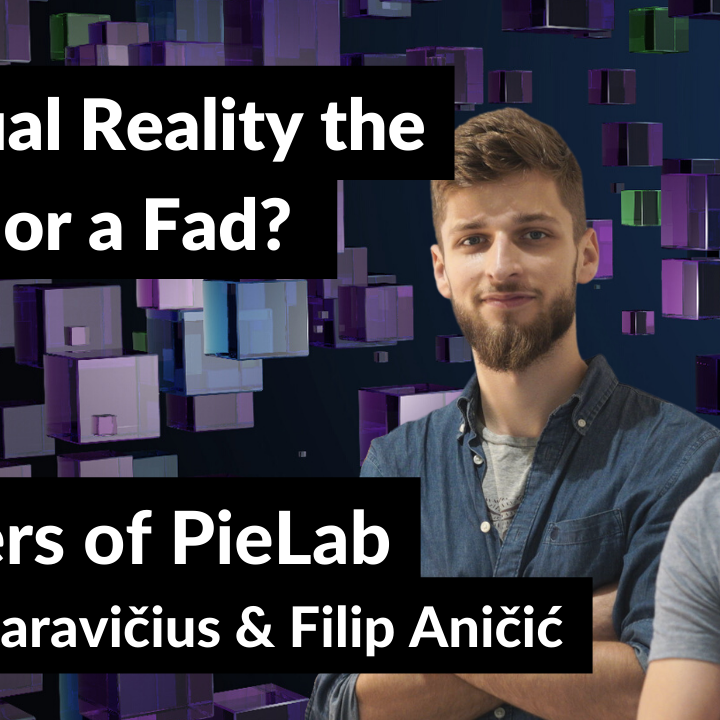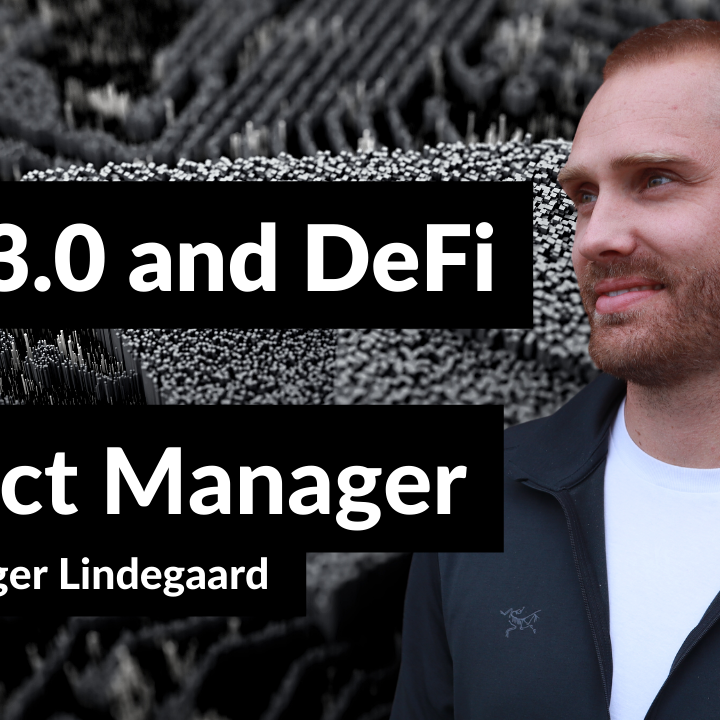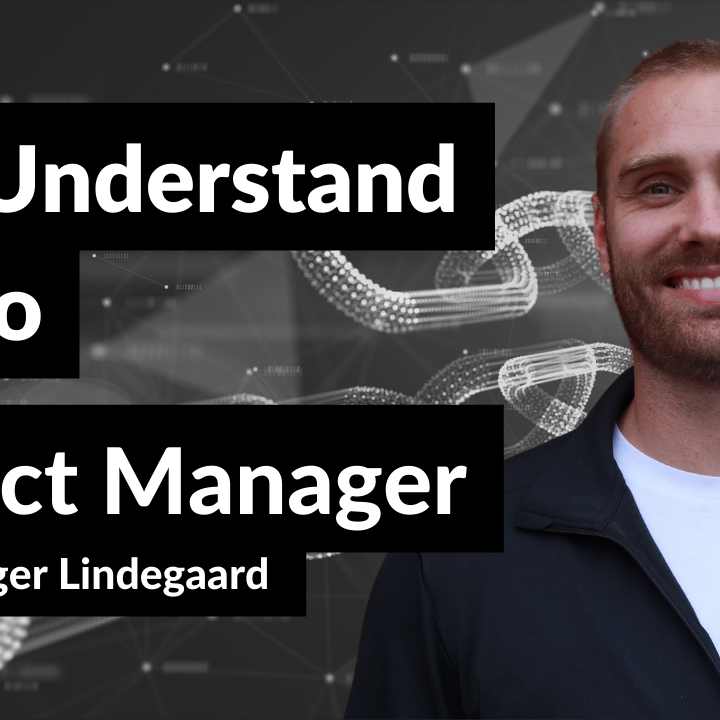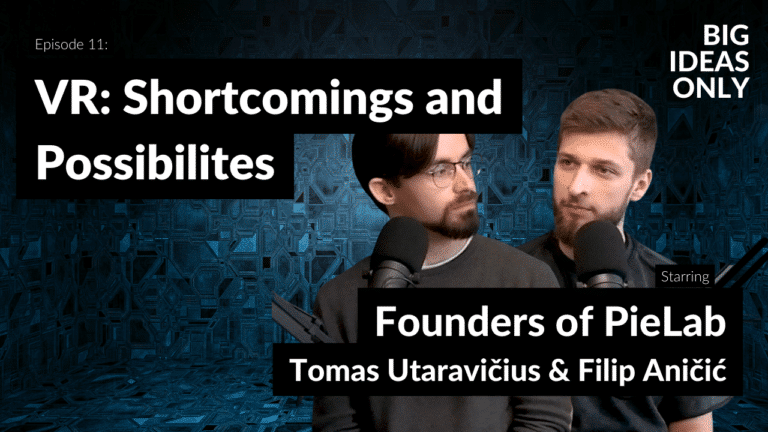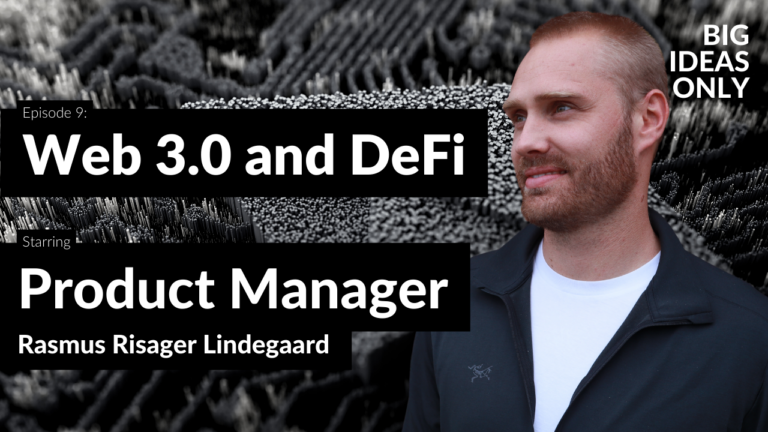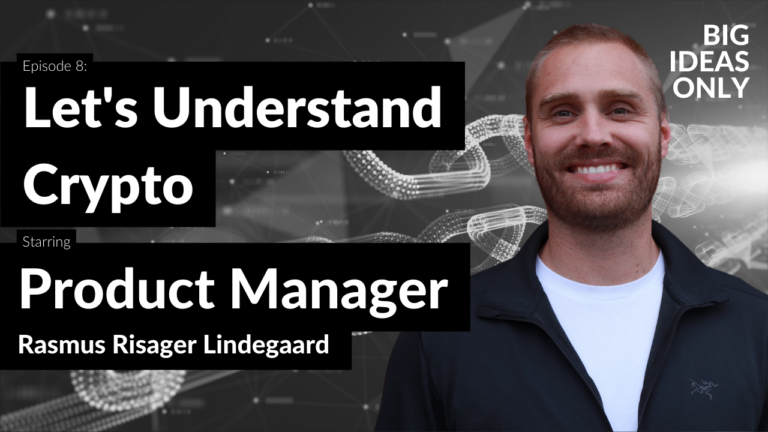To enlighten us on the topic, the founders and partners of the VR and AR studio PieLab, Tomas Utaravičius and Filip Aničić, have come to our rescue.
Your host is Mikkel Svold, CEO of Montanus, who will guide you through this interesting topic.
This podcast is produced by Montanus.
Link up with Tomas Utaravičius
Link up with Filip Aničić
Link up with Mikkel Svold
Listed below are the most essential timestamps from the podcast episode to make it easier for you to find the topics that interest you.
00:23 Welcome
01:59 Recap of the last episode
02:37 What is PieLab?
05:44 Practicing using VR and AR
08:16 How did Filip and Tomas get introduced to virtual reality?
12:16 What are the opportunities and shortcomings of VR and AR?
12:54 Metaverse
18:13 The shortcomings of the Metaverse
19:24 Technical perspective and a current USA Military use case
21:45 The Advantages of Computer vision and Machine Learning
24:22 AR and VR are marketed above their capabilities
24:58 Is VR become mainstream?
29:06 When will AR become mainstream and the Nreal glasses
32:13 What is the future of augmented reality and virtual reality?
34:32 Sum-up of the two episodes
35:31 Outro
Recommended
Mikkel Svold (00:23):
Hello and welcome to Big Ideas Only, welcome back. This podcast is powered by Montanus, where we specialize in producing high quality content for marketing departments in engineering and knowledge driven companies. And in this episode, we’ll continue the talk that we had in the last one, and now we’ll try to look into the possibilities and shortcomings of virtual reality and augmented reality. And if you haven’t heard the first episode, go back and listen to episode 10 and that’ll get you up to speed. And that’s also basically where we’ll start off. Now my name is Mikkel Svold and I’ll be asking all the questions and to answer, I again, have my two guests, both founders and partners in the VR and AR studio, PieLab. First of all, and now I’m going to try this name. Welcome to you, Tomas Utaravičius.
Tomas Utaravičius (01:14):
Thank you.
Mikkel Svold (01:15):
Was it good? That was pretty close.
Tomas Utaravičius (01:17):
Yeah.
Mikkel Svold (01:18):
And secondly, welcome to you, Filip Aničić. That’s also pretty close, wasn’t it?
Filip Aničić (01:23):
Pretty good.
Mikkel Svold (01:24):
Yeah. Can you say it?
Filip Aničić (01:26):
Aničić.
Mikkel Svold (01:26):
Okay, I’m not going to try to repeat. Well, welcome to you again. And I think first let’s just have a real short recap of the last episode. Basically, we talked about what virtual reality is, what augmented reality is. So virtual reality being this entire virtual space that you basically enter. And augmented reality being something closer to the more commonly known, like Pokemon Go kind of thing where you put virtual things into the real world.
Filip Aničić (01:58):
Got it, right.
Mikkel Svold (01:59):
Thanks. And also, we talked about some of the applications for these two technologies where I think especially the educational part of… Obviously there’s a gaming part, but the educational part of these technologies are really exciting because you can now train in stuff. I think Tomas just said, you can die several times learning electricity or learning some craft that’s really hard. You can know how you will die before you actually do it.
Filip Aničić (02:32):
You can try failing without actually having the consequences of failing something dangerous.
Mikkel Svold (02:37):
Exactly. And I think that’s one of the really cool applications for VR and AR. Now Filip, can you just real quickly just recap, what does PieLab do?
Filip Aničić (02:52):
So, we do virtual and augmented reality content where we want to improve the state of education and… I haven’t practiced this in a long time. So in PieLab, we use the latest technology of virtual reality and augment reality to improve, to try to improve some education, digitalization and what’s called, onboarding and stuff like that.
Mikkel Svold (03:26):
And onboarding, there’ll be like the training stuff.
Filip Aničić (03:29):
Training, yeah. So, with this technology, there’s a lot of possibilities and we try to find a spot in the middle with our customer how to integrate with their current workflow to improve it. So there, it benefits us that we can learn a new field to integrate to, but also benefits the client where they are able to improve their education or whatever system that they wanted to improve.
Mikkel Svold (04:03):
And I guess for, I know that you did the Roskilde virtual experience when COVID closed down Roskilde Festival, which is a music festival. And I think for those applications, that’s obviously in the entertainment part, but it’s also actually something that keeps Roskilde Festival some kind of alive, although they were closed down, which is really cool. And also on other business areas, it’s more companies, they save a lot of resources. Because training and teaching and onboarding, new staff members, new technicians become so much easier and so much cheaper. And you can repeat the process again and again and again without it costing anymore.
Tomas Utaravičius (04:49):
It’s actually a lot about the scale. If you have lots of people run through the same program, it makes lot of sense. Walmart, for instance, they actually bought, I believe around one million headsets, units to teach their staff in the stores. They teach virtual scenarios where people are being complicated, where people are being this or that. So they actually…
Mikkel Svold (05:17):
Oh. So, they basically teach people how to react on certain customer experiences.
Tomas Utaravičius (05:22):
Exactly.
Mikkel Svold (05:23):
So, if you have a mad customer for whatever reason-
Tomas Utaravičius (05:26):
They teach them these scenarios because generally you would need some sort of an actor, I believe, for each session when you need to teach them. But you can just simulate that, of course it’s not as good as an actor, it’s never going to be. But if you run that through one million people, I believe it’s worth it.
Mikkel Svold (05:44):
Now we will jump away from some of my questions, but I want to jump into this because practicing, you say that practice make perfect. But does practicing in a virtual world, something like this, something like the Walmart, I get that practicing that, “Okay, you can’t touch this wire over here because that will electrocute you.” But practicing social interactions, do you think it works or do you think… Well, do you think it doesn’t work?
Tomas Utaravičius (06:15):
Well, I think the alternative here is that they are either going to have it in virtual reality or they’re not going to have it at all.
Mikkel Svold (06:24):
So, it’s better than nothing. That’s also what you’re saying.
Tomas Utaravičius (06:26):
That’s what I’m saying, exactly. Because generally they wouldn’t have budget to train people in those scenarios because suddenly the training is not one or two weeks, or I’m not actually sure how long is their training for the store staff. But I just believe that when it comes to having to train people for these edge cases, that’s where virtual reality is really good for.
Mikkel Svold (06:53):
Yeah, Yeah.
Tomas Utaravičius (06:55):
Even in social scenarios.
Filip Aničić (06:57):
I think, just even if the scenario, it’s quality or is not up to par to anything real life, just if it’s something close to, if it replicates some specific piece, some important piece about that. Like maybe the tone of the customer that comes in and stuff like that. Just trying, going through that simplified virtual scenario prepares you at least a bit somewhat. So I think it’s good because you can condense those sort of scenarios and training, it can be a lot faster, a lot cheaper and stuff like that. And then your staff is also for that, still smaller cost, your staff is still prepared, has those small tips on how to-
Mikkel Svold (07:55):
Yeah. They have the tools.
Filip Aničić (07:56):
… Yeah. To handle those more rare scenarios.
Mikkel Svold (07:59):
And also now, I don’t know much about Walmart, but they don’t seem like a company that would buy a million headsets if it wasn’t working. So that in itself, I think, explains quite a lot. They would’ve probably been testing before investing.
Tomas Utaravičius (08:14):
They usually have smaller cases beforehand.
Mikkel Svold (08:16):
Yeah, obviously. Obviously. Now, we talked about some of this before we turned on the microphones, and I think it’s fun because I want to know, why did you get hooked, the two of you? Why did you get hooked on virtual reality? Where does that interest come from, Filip?
Filip Aničić (08:35):
I guess maybe it be similar to our prior episode. Video games proved you can be in different environments, you can play a different character and stuff like that. This just is the next generation of what we had with computer games, with video game consoles on the TV or on a monitor. So it’s an extension of what’s being made in the last, let’s say, 50 years of virtual content. So I think that we just see examples of those video games and on Star Trek and stuff like that. The science fiction of it, there is a certain appeal and I don’t know, would that kind of summarize?
Tomas Utaravičius (09:27):
Well, my points are somewhat the same. It’s also coming from video games, and for me it’s all about having different type of interaction with the world. When you have a controller or a mouse and keyboard. Is different. But when you are inside that world present, you can have a sword fight. I find that very amusing. You can shoot a bull. I find that also very amusing. And that’s basically what draws me into that.
Filip Aničić (09:51):
Or I actually get the point that it’s maybe not specifically what… Well, there is that part about video games, but the other value that we want to bring to that could help the real world more. What VR also solves from the applicability of the education and entertainment and stuff like that. Putting humans more closer together rather than their digital profiles on LinkedIn, on Instagram, on Facebook and stuff like that. It’s a bit shallow. It doesn’t represent you. It represents your caricature that you put on the internet. And I think virtual reality allows you that you can have some sort of facade, you can have some sort of character. But I think when you’re face to face with a person, you still show yourself in some sort of way, show yourself a lot more than you would be on Facebook and on Instagram and stuff like that.
Mikkel Svold (10:57):
But is that a strength or weakness with virtual reality?
Filip Aničić (11:00):
I think it’s a strength because I think we shouldn’t be over… You can indulge into being online caricature to a certain extent, but I think it’s a bit in the history of humans, in the history of what we know, it’s a bit unusual. And I think there’s a lot of people that notice that people aren’t happy as much. We have all the information in the world that you can get, even you’re in a poor country, if you have some internet, you can learn a lot of stuff. You can learn, teach yourself a lot of those things. But still, it feels like there’s positives and there’s negatives that came with the internet, with social media specifically. So I think it’s just that we want to improve it. So it’s more about humans and about humans interacting rather than marketing, selling ads and stuff like that, which is the bad side of capitalism. While we like the ideal part of capitalism where it… I’m not sure would be. You have good social morals and also good markets. I think that’d be the ideal version.
Mikkel Svold (12:16):
And I think that leads us onto the other question on the next question that I’ve written down and is, what are the opportunities within VR and AR. And what are the shortcomings, do you think? Where do you, Tomas, do you see the biggest opportunities within virtual reality?
Tomas Utaravičius (12:42):
I believe that the Metaverse idea has something.
Mikkel Svold (12:48):
Okay. And I think we need to explain that also because you mentioned that actually also in the last episode. And what does that mean, the Metaverse?
Tomas Utaravičius (12:54):
Well, if defined by Meta or Facebook, it’s basically the idea of all people being connected online through some sort of virtual profiles. Preferably to through virtual reality, because that’s probably the easiest. While I don’t really agree with everything that it entails, I think the idea of you being able to simulate certain scenarios in multiplayer environment where it makes sense to be multiplayer. Especially in education or games, I really enjoy those scenarios. I think there’s a huge value in that.
Mikkel Svold (13:33):
Just for me to understand it, the Metaverse, idea behind the Metaverse, is that something you enter into or is it something that will just engulf our reality as well?
Tomas Utaravičius (13:48):
I think it’s quite hard to say, but if I had to put some sort of a basic description of it, that would be just a general application where people can connect to and maybe just talk to each other. Like A VR chat. VR chat is some sort of an idea that Metaverse should be.
Filip Aničić (14:05):
It’s one of the better examples of something that’s out there that you can actually try. Because the way it works is that you make yourself a virtual avatar and you can go around to different servers and traverses through the rooms in there, then socialize with people. Then there’s specific, you can have games and stuff like that and bars and stuff like that.
Mikkel Svold (14:32):
But to me it seems a lot of extra layers. You say you have to go to a room, blah, blah, all this, you have to virtually move around instead of just sending an email.
Filip Aničić (14:42):
Well, I mean, it’s virtual socializing. So that-
Mikkel Svold (14:48):
An email is not per se socializing. It’s Information.
Filip Aničić (14:51):
It’s transfer of information, and it’s also, it’s nice and concise. So there are definitely benefits of email. And the Metaverse is not going to remove email for some reason why. You’re not going to make stuff that’s easy now, more convoluted. The thing is giving more opportunities, more mediums inside of virtual spaces that people can test around and see and innovate, try to innovate in. So if you can think about it as a broadening of a medium or a creation of a new medium, similar to how film came in, similar to how TV came in.
But now this is even broader more because how technology advances it gives more and more opportunities for new stuff to be created. So there is a difference, in the Metaverse can be something very dystopian and can be something very utopian. But I think it’s like a coin, both sides of coin. I think personally, if Metaverse would be created, I wouldn’t want it to be run by a specific company or specific conglomerate of companies. I don’t want Microsoft and Facebook will be the only ones to run it. You want it to be something like the internet that you are not shackled to be in one place. You can go wherever you wish, and you can make your own space if you want to make there.
Mikkel Svold (16:26):
And what is happening then? Is that what’s happening? Is it becoming this, like the internet? Or is it actually Facebook that is just pushing this agenda through?
Filip Aničić (16:35):
So publicly, the TV, on the news Meta has the most-
Mikkel Svold (16:40):
And just to be clear, Meta is Facebook. They changed the name just …
Filip Aničić (16:43):
Yeah.
Mikkel Svold (16:44):
Yeah, just a couple of weeks ago. Well, month ago, I guess.
Filip Aničić (16:47):
Yes, a year you could say. I think they’re the ones that are publicly spending the most money investing into this, and they’re utterly failing at it. Because there’s a difference between management and reality because some people from our perspective as the ones having to build the bricks. Or assemble the bricks into a building in the virtual spaces with the programming and software development. And 3D modeling and texturing and stuff like that, is that we see there’s a lot more work to be done.
The Metaverse is an abstract, abstract sort of an idea. And there’s no actual form to it. It’s the same thing as people didn’t know what internet would be in the eighties, and then it organically grew into it. So, I think that the big companies like Meta would, they’re going to fail… They’re failing to force, they’re failing in the public opinion that are into this sort of thing, that want to view this, what’s going to happen in this industry. They’re failing to push something that’s supposed to grow organically. So I think that’s the notion that a lot of people have, it’s just that there’s a dysfunction and what they’re marketing and what they’re actually doing.
Mikkel Svold (18:13):
And the shortcomings just to round off that end of the topic. So the shortcomings of the Metaverse as it is right now is what? It’s not realistic enough or it’s…
Filip Aničić (18:27):
Not visible to create it. There’s no interconnect to you… So one of the things that people say is if you make something for one game, you can put that exact thing in another game, but that’s not actually feasible. You can maybe transfer the model and stuff like that. But the logic there and stuff like that, there’s nothing like that sort of exists. That sort of thing like transferring data between all these different entities in the virtual space is what the Metaverse is marketed as. But the visibility of that doesn’t seem realistic.
Tomas Utaravičius (19:17):
You currently just talked about somewhat of a social part-
Mikkel Svold (19:21):
Can you just your mic a little bit?
Tomas Utaravičius (19:22):
Sorry.
Mikkel Svold (19:23):
Thanks.
Tomas Utaravičius (19:24):
Yeah. So, Filip, you just talked about the somewhat social part of it, there was a social topic in this. But from the technological perspective, when it comes to opportunities and shortcomings of virtual and augmented reality. Well, we’ve been throughout the opportunities when we talked about the use cases, training, games, visualizations, social stuff. But when it comes to, let’s say, opportunities of augmented reality, there’s a very interesting case for that. Currently, Microsoft just sold 22 billion worth of augmented reality headsets to USA military.
Mikkel Svold (20:06):
Oh yeah.
Tomas Utaravičius (20:07):
So that happened, and the soldiers are being trained to use those. And I’m not sure how many units that entail because the cost of one Microsoft HoloLens, that’s the augmented reality headset is around $3,000.
Mikkel Svold (20:23):
You would think that they could get some kind of discount when they…
Tomas Utaravičius (20:27):
I would almost think that actually was more expensive per unit because they were probably some very custom version of it, so it fits. They’re being trained right now, and the idea is that these glasses are going to help the soldiers to receive more information live. And help them see things that you wouldn’t generally see.
Mikkel Svold (20:47):
But now we are talking augmented reality, right?
Tomas Utaravičius (20:49):
Yeah.
Mikkel Svold (20:49):
We’re not talking the headsets where you block out your entire vision of the real world and you enter…
Tomas Utaravičius (20:55):
So, the virtual reality headset does block out your vision completion.
Mikkel Svold (20:58):
Yeah, the VR.
Tomas Utaravičius (20:59):
The augmented reality puts goggles on top of your eyes. So they can track the-
Mikkel Svold (21:04):
Yeah. And like we mentioned in the last episode, I think the most known kinds of goggles will probably be the Google glasses that were introduced and then canceled again. And now Microsoft that’s basically taking up that idea.
Tomas Utaravičius (21:17):
There are some attempts to recreate Google Glass. There’s this thing called Unreal, I believe that’s how it’s called. And it looks like just regular sunglasses.
Filip Aničić (21:25):
Like Ray-Ban glasses.
Tomas Utaravičius (21:27):
Like Ray-Ban, well there’s still a battery there, so they’re somewhat more bulky, to the sunglasses.
Mikkel Svold (21:36):
But coming back to the US military, I think that’s a quite interesting case. Why would they need augmented reality?
Tomas Utaravičius (21:45):
I think it just boils down to having advantage somewhere, having some sort of a computer running synchronously with you, with the soldier. I think there’s a huge advantage for you to be able to see something that you might not be able to see or recognize as easily, because we work differently than computers do. Computers have computer vision, which is able to, through machine learning, recognize objects that you don’t see with your naked eye. In some cases, computers with certain types of cameras are able to tell the distance that there is something in front of you. While you cannot do that on your own, even in the night. Tesla, for instance, they have around six cameras in the car, I think all around the car. There’s a system called LiDAR, which is an infrared signal to basically tell-
Filip Aničić (22:40):
They’re not using LiDAR anymore.
Tomas Utaravičius (22:42):
Oh. They’re not using LiDAR anymore, that’s true. They’re using regular cameras now because LiDAR was too expensive. But initially they were using LiDAR and with LiDAR you can tell what’s the distance between you and this person that you’re about to hit.
Mikkel Svold (22:55):
And now they’re just using regular cameras-
Tomas Utaravičius (22:57):
Regular cameras.
Filip Aničić (22:58):
Regular cameras with AI, basically machine learning to recognize everything. They recognize the patterns, just using a regular camera. An example that’s relevant to how we’re talking, the US military using the HoloLens that Microsoft provided. It’s a good example of how there’s a large interest and then how also the technology is still not ready. Because there were tests being done that recently publicized, I think maybe a week ago or something like that. Where it was tested by the US military having these augmented reality goggles in field, in testing during combat and stuff like that. And one of the results was that a large majority of the participants, the soldiers, had motion sickness, had-
Mikkel Svold (23:57):
Oh, really?
Filip Aničić (23:58):
… strain on the eyes and inside of stuff. And that was one of the apparent things in the article. And you would expect, it’s such a negative result, such a negative results from those tests. But the US Army is still adamant about that, they’re still investing in this, they see a potential in this.
Mikkel Svold (24:17):
But they just need to refine how to actually use it.
Filip Aničić (24:22):
Yeah. And that’s what we are saying. Is augmented reality and virtual reality of fad, or is it the future? Well, currently it is a fad because it’s being marketed above its capabilities. And the market, the price of the technology is not to a low enough point that it’s a high quality enough and then it’s accessible. But people that tried it, see the potential in it. And people that can invest, they seem to invest, they’re trying to maybe invest in long term or something like that.
Mikkel Svold (24:58):
And what do you think we need, what VR and AR, what do those two ideas or those two products, what do they need to become mainstream? What is holding them back so to say?
Tomas Utaravičius (25:15):
Well, when it comes to virtual reality, I feel like it’s becoming mainstream, quite mainstream. There have been over 20 million headsets sold by today, I think. Oculus, well, Meta has sold over 15 million. There are definitely over five million PlayStation VR headsets sold. And the sales are not going down, they’re actually increasing.
Mikkel Svold (25:43):
Okay. But are these, because it sounds like large numbers, but it can both be large and small number basically.
Tomas Utaravičius (25:52):
It’s relevant.
Mikkel Svold (25:53):
Yeah, it’s relevant. It’s relative to the people having owning a computer, for instance. And I was just thinking, is it still the technological front runners that buy these headsets? Or when will it come into that bulk of people who are not the first movers?
Filip Aničić (26:15):
I think it needs to acquire a level of maturity that we believe it’s still not there. Because there is still, even though… Okay, so now we’re in the case where there are affordable virtual reality headsets. So virtual reality is a bit ahead of the curve against augmented reality in that case. Because you can have quality enough virtual reality and for an affordable price, let’s say, depending on the economy. But there are some pitfalls there.
So, for example, the most affordable one is Oculus, is the Meta Quest 2, which is a standalone headset, and basically has the same hardware as a mobile phone, Android smartphone. It’s not quite powerful enough to give you those breadth of experiences, having a larger environment that maybe you would have playing on a PlayStation or an Xbox because it’s small, compact, standalone. And if you wanted higher fidelity, you would probably need to have a gaming PC that you can connect with by cable or wirelessly. And what we are hoping is that we need improvement in the horsepower to make it better. And we also need improvement in the software of the headset itself to make it a lot more straightforward.
Mikkel Svold (27:43):
And I guess those two things, they will come pretty naturally, won’t they?
Filip Aničić (27:47):
Yes.
Mikkel Svold (27:47):
It’s just-
Filip Aničić (27:49):
And then the third thing would, that’s also important because you have to have the software on that platform. So, there’s one thing of the operating system that runs on the headset. And the second thing of being the software that you can get, for example, there’s Beat Saber on the old virtuality headsets. A lot of people it, it’s very nice, physical sort of game.
Tomas Utaravičius (28:18):
It’s a virtuality game.
Mikkel Svold (28:21):
Yeah, okay.
Tomas Utaravičius (28:21):
Very popular.
Filip Aničić (28:21):
And there’s a couple of those, but it seems there’s still a lacking of games. And if you look, for example, if you want to have some interesting experiences like playing games or something like that. You might just go to a console or a gaming PC because there’s the library of titles is a lot larger and more versatile. While on VR is still more niche because the market’s still smaller. So I think what’s happening is that you have already the first, second, and maybe third wave of adopters and still needs to maybe go a couple of more years, so the market expands. And then it’s going to be a lot more approachable for the mainstream, the general.
Mikkel Svold (29:06):
And what about augmented reality?
Filip Aničić (29:09):
I think it’s still a bit behind, I think the Nreal Glasses are pretty cool. They don’t do any tracking outside the headset, but what they do is that you, it’s nice, sleek pair of glasses that are Google Glass, a newer generation of it. That you can project, it can be just a large projector, but on your head, you can have a hundred inch TV in front of you. And it’s a nice, good, dense quality and it’s pretty cool. But that’s pretty limiting. And the ideal augmented reality glasses are like HoloLens, but they still have the issue, they’re too expensive, they’re still too bulky. The quality of the projection of augmented reality is still pretty bad. And the field of view is still a small, tiny box. A small window in front of your eyes.
Tomas Utaravičius (30:10):
So, for instance, as humans, we see a lot, we see almost 181, vertically, oh, sorry, horizontally. And then maybe 150 vertically. And these glasses give you 60 horizontal-
Mikkel Svold (30:24):
60 degrees.
Tomas Utaravičius (30:24):
Yeah. So, you do imagine that when you put these on, you only have the small box in front of you, well, relatively small box that you can see content through, and that’s breaking immersion. And then you are still wearing these huge glasses and those Nreal Glasses that Filip talked about. Yeah, they look nice, but they don’t do anything that real augmented reality glasses should do. In my vision, augmented reality glasses are supposed to be able to track the environment so they can put the content on the environment. You arrive at the store, you look at the price tag of something, and then you suddenly see maybe a 3D presentation of it.
Mikkel Svold (31:04):
And this is already happening through your phone, but that’s through your phone.
Tomas Utaravičius (31:10):
You have to hold it.
Mikkel Svold (31:10):
You have to hold your phone. If you take a Google Street view and you hold it up, your camera will actually turn on and it. I think it’ll show you the way or something if you have a direction. I think I saw somewhere where they had a little fox running. So you just follow the fox and then you’ll arrive at your destination, basically. It was just a fun little thing. But that goes through your phone. And what we essentially want to do is get away from the phone and get it straight in front of your eyes, because that will… We need the seamless integration with reality for it to work properly.
Tomas Utaravičius (31:48):
The tracking needs to be very, very precise. It shouldn’t drift. It should be anchored in a place very precisely. And the FOV is really, really important for you to actually be fully immersed in the world where it feels like augmented reality, the one that we saw in sci-fi movies.
Mikkel Svold (32:05):
Yeah, Yeah.
Tomas Utaravičius (32:06):
So, we are pretty far from that. I would say that if I had to take a guess, it would be five to 10 years in hardware at least.
Mikkel Svold (32:13):
And talking about that, what do you think, and we are running out of time a little bit, but what do you think is the future of augmented reality, virtual reality? And you mentioned five, 10 years. Is that realistic or is that optimistic or pessimism?
Filip Aničić (32:30):
It’s optimistic.
Mikkel Svold (32:31):
Optimistic, fair enough.
Filip Aničić (32:32):
I feel it’s optimistic. I wish it was there in five to 10 years, then I feel like it has-
Mikkel Svold (32:37):
The fully immersed, or not submerge, but immersional experience where you integrate seamless, leave through your glasses and you just basically have it in your field of view.
Tomas Utaravičius (32:50):
It needs to improve a lot on a lot of different fields. Price, bulkiness, performance, there’s lots to go. Unfortunately, there’s lots to go.
Filip Aničić (33:03):
I think from my perspective, for augmented reality, virtual reality, whatever devices in between or extending it, and also in the term of the Metaverse or what people want to strive to make it. I think what needs to be done is to enable easier creation of that content. Because I see that a lot of it, to create realistic stuff is very high, takes a lot of resources, takes a lot of time. You need to already have people that are very good at that. And it’s not very affordable, it’s not very scalable. And I think creating new tools to enable artists, to enable designers and people in all different fields to try to make content easily. To make those environments that you want, I think those are the things that need to be improved, need to make it more accessible to make those sort of environments. If that gets accomplished, if it gets a lot cheaper, a lot faster to make it. And I think that is going to help a lot. If that gets accomplished in the next five years, I think then that it would succeed a lot better.
Mikkel Svold (34:32):
Yeah. So, I guess the conclusion from these two episodes on whether virtual reality, augmented reality, you did the loop quite nicely. So the conclusion is that, right now it’s still kind of a fad. It’s at least reserved for very specific use cases. A lot of gaming. A lot of gaming and training. And if certain things happen, developments happen and they probably will happen, I feel. It will actually become something that we will use properly in the future. Like we use a computer, like we use the television when that came around. Super exciting. Our time is now up. And Tomas Utaravičius, I’m getting good at this. And Filip Aničić, that was the best one, wasn’t it?
Filip Aničić (35:25):
Yeah.
Mikkel Svold (35:26):
Thank you so much for coming by. It’s been a real pleasure.
Tomas Utaravičius (35:29):
Thank you.
Filip Aničić (35:30):
Thank you for having us.
Mikkel Svold (35:31):
Absolutely, absolutely. And to you, dear listener, if you like this episode, help us spread it by subscribing, of course, and also giving it a five star review if you feel like it. Share it with your friends and family if you think they would find it interesting. Now, we’ve talked about a lot of things and a lot of different types of glasses and a lot of things have been mentioned. And all of that will be linked to in the show notes. And those show notes you can find on our website montanus.co/bigideasonly. And that is co without the M in the end, so montaus.co/bigideasonly. And of course, if you’re interested in building your own thought leadership or building thought leadership for your own company and having your own content universe get started blogging, all that jazz. Don’t hesitate to reach out to us. And you can do that on our website as well, montanus.co. And that’s it for now. Thank you so much for listening.
